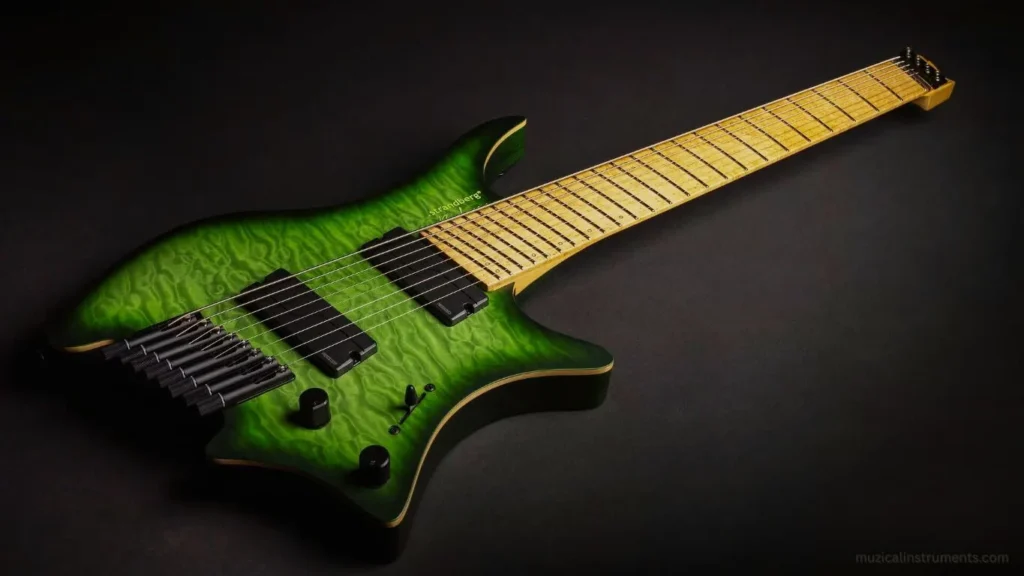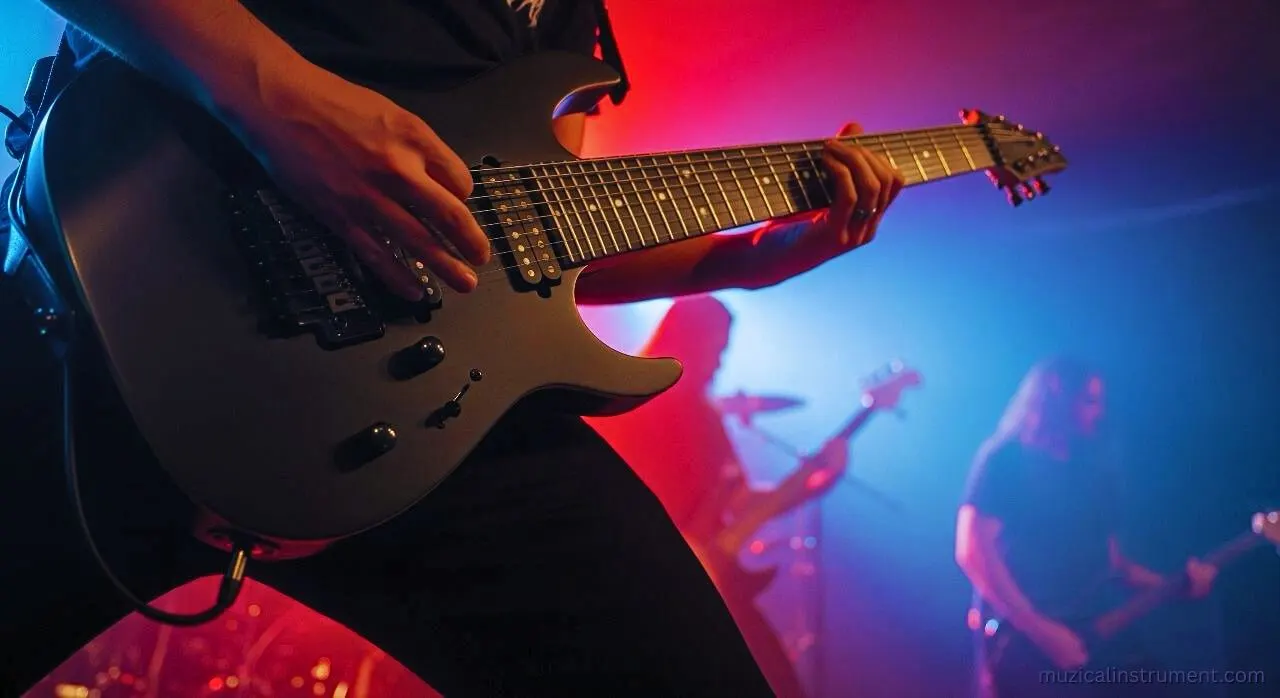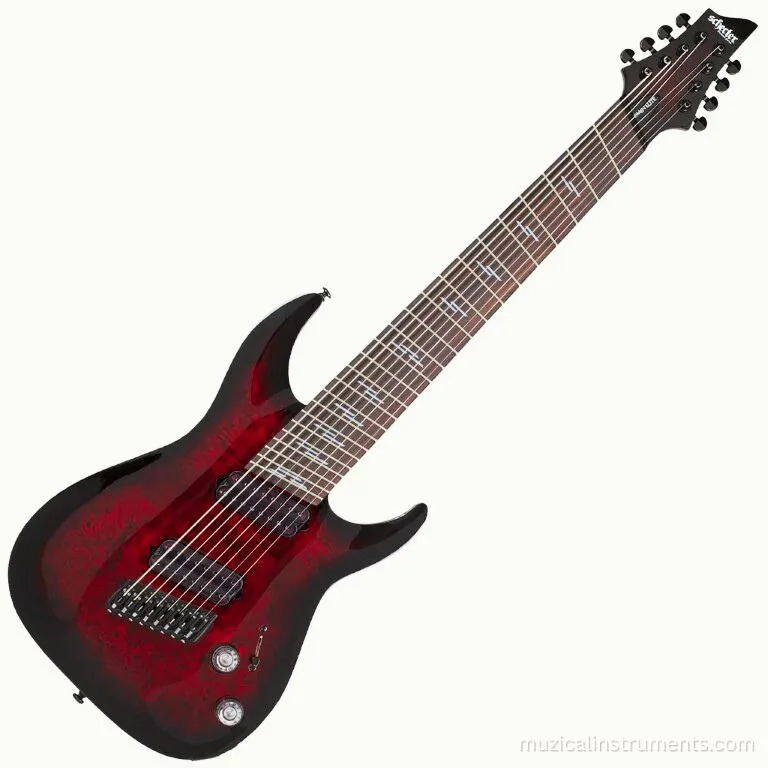What Is an 8 String Guitar Used For? And Should You Actually Get One?
What is an 8 string guitar? An eight string guitar has two extra strings. These give you more sound. You can play heavy Drop E riffs or smooth jazz runs. Some players even use it for classical music. It lets you go low like a bass and high like a lead guitar, all on one neck.
It looks bigger than a normal guitar. It sounds deeper too. It’s not just for pros like Tosin Abasi or bands like Meshuggah. It can be for you.
One popular model is the Ibanez RG2228. It was built for this kind of power. Still, the neck is wider. The strings feel tighter. So yes, it takes practice. But if you love deep tones and new sounds, this guitar opens new doors.
You’re here because you’re curious. Maybe you want more range. So, let’s explore if this guitar fits your hands and your music.
What is an 8 String Guitar?
To really understand what is an 8 string guitar, you need to see how it works. It’s not just a guitar with more strings. It’s a new tool. It gives you an extended range, both low and high.

A regular guitar has six strings. A 7-string adds one more. But an 8-string gives you two extra. This means you can play bass notes and lead parts without switching instruments.
The body looks almost the same. But the neck is wider, and the frets are longer. Some models, like the Ibanez RG2228, even use a baritone scale to make low notes sound tight and clear.
It is something you must learn to become accustomed to. Your fingers will even lengthen a bit. But when you do know it, you will be aware of the difference. You will sense you can play anything soft jazz, loud metal all on one guitar.
That is what sets an 8-string guitar apart. It’s not so much about more strings. It’s about more music
Where Did the Eight String Guitar Come From?
You might think 8-string guitars came from metal. That’s true, but not the full story.
Long before heavy riffs and low tunings, some classical players were already using more than six strings. Back in the 1800s, people like Giulio Regondi and Luigi Legnani wanted fuller sounds. Their guitars looked different, but the goal was the same: more range, more music.
Then came jazz.
In the 1960s, a player named Ralph Patt got tired of stretching his fingers for tricky chords. So, he changed his tuning. He used something called major-thirds tuning. That gave him a smoother way to play fast jazz runs. Simple shapes, rich sounds. Smart move.

But the real game-changer? Meshuggah.
In the ‘90s, this metal band wanted heavier, deeper tones. Six strings weren’t enough. So they picked up 8-strings. That low-end growl hit hard and fans loved it. After that, the 8-string guitar took off in the metal scene.
Today, it’s not just metalheads using it. Classical guitarist Paul Galbraith plays a custom 8-string he rests upright, like a cello. It’s called the Brahms guitar, and it sounds beautiful.
So yeah, the 8-string guitar has a wild mix of roots old and new, soft and loud. That’s what makes it so special.
Why Do Guitarists Choose 8 Strings? (Genre by Genre)
Let’s be honest. You’re not looking at an 8-string just for fun. You want to know what it does and if it fits the kind of music you love. So let’s break it down by style.
If you play metal, this guitar was made for you. The low strings give you that thick, deep sound you hear in bands like Meshuggah. That’s called Drop E tuning, and it hits hard. Think chunky riffs, fast picking, and tones that shake the floor. That’s why players like Tosin Abasi love the 8-string. It’s not just low, it’s clean, tight, and sharp.

If you’re into jazz, the 8-string gives you room to stretch. You can play deep bass lines and rich chords at the same time. Some players use it like a mini piano. You’ll have space for tricky shapes and smooth solos without running out of notes.
If you like classical music, there’s something for you too. The 8-string gives more range for old pieces that don’t fit on six strings. A few players, like Paul Galbraith, even use a custom design that sits upright like a cello. Sounds weird? Maybe. But it works and it sounds full and warm.
If you just like to experiment, this guitar is wide open. You can tap, slide, loop, bend, or do all of it at once. Players like Sarah Longfield use 8-strings to create layers of sound that feel huge even when they’re playing alone.
So, why choose an 8-string?
Because it lets you do more. And if that’s what you’re after, you’re in the right place.
Who Plays 8 String Guitars and Why?
Still wondering what are 8 string guitars really for? The best way to find out is to look at who’s using it and what they’re doing with it.
Let’s start with Tosin Abasi. He plays in a band called Animals as Leaders. If you haven’t heard him yet, go look him up. His playing is fast, clean, and full of layers. With an 8 string, Tosin can play bass notes, chords, and leads all at the same time. For him, this guitar isn’t just an instrument. It’s a full band in his hands.

Then there’s Sarah Longfield. She’s known for tapping both hands on the fretboard, like a piano. The 8-string gives her room to build big, rich sounds without needing extra gear. Her style is smooth, creative, and full of emotion. The extra strings let her explore more space, more feeling.
On the other side of the music world, Paul Galbraith uses an 8-string in classical music. His guitar, the Brahms guitar, stands upright like a cello. It has extra strings and a longer neck. That means more range and more depth perfect for pieces written for other instruments. With it, Paul plays Bach and Mozart with power and grace.
So, what is an 8-string guitar? It’s different for each player. For Tosin, it’s about speed and control. For Sarah, it’s about texture and sound. For Paul, it’s about beauty and reach. The truth is, this guitar becomes whatever you need it to be.
How Is It Built Differently?
When you’re trying to figure out what is an 8 string guitar really, you have to look at how it’s made. It’s not just about adding two more strings. The whole guitar is built to handle more power, more range and more control.
First, let’s talk about scale length. That’s the distance from the nut to the bridge. On an 8-string, it’s often longer than a regular guitar. Why? Because lower strings need more tension to stay tight. If the scale is too short, those low notes get floppy and muddy. A longer scale like the one on the Ibanez RG2228 keeps everything sharp and punchy.

Then there’s string tension. You’ll feel it right away. The low strings are thick, and they fight back more when you pick or bend them. That might sound tricky, but it actually helps you play cleaner, especially in Drop E or other low tunings.
Now look at the neck. It’s wider no way around that. You’ll need to stretch your fingers more, and chords will feel different at first. The wider nut gives space for all eight strings, but it also changes how your hand moves along the fretboard. Some players love it. Others need time to adjust.
To make things easier, some guitars use fanned frets. These aren’t straight, they’re angled, like a fan. It might look strange, but it’s actually more comfortable. The fret shape matches the natural curve of your hand, so it feels smoother when you switch from low to high strings.
And then there are the pickups. A lot of 8-strings use EMG pickups, especially on metal-focused models. These pickups are active, they boost your signal, clean up noise, and give your tone extra punch. The EMG 808, for example, is a popular choice for high-gain playing.
So, what is an 8-string guitar? It’s a full redesign built for strength, clarity, and comfort. Every part of it is made to handle more sound without losing control.
Pros and Cons of Playing an 8 String Guitar
So, you’ve been learning what is an 8 string guitar. Now the big question, should you get one?
Let’s look at the good and the tough sides, plain and simple.
| Pros | Cons |
|---|---|
| More range, more sound. You get deep bass and high leads in one guitar. | Bigger learning curve. More strings mean more thinking and adjusting. |
| Great for metal—and more. Djent, prog, jazz, fingerstyle—it works across styles. | Wider and heavier. The neck and body feel larger; your hands stretch more. |
| One guitar, full setup. Play rhythm, lead, and bass lines all at once. | Not for casual strumming. It’s more complex than a standard 6-string. |
| New creative paths. Forces you to write and play in new, exciting ways. | Gear limitations. Some amps and pedals don’t handle the low end well. |
In the end, what an 8 string guitar gives you is freedom but it also asks for commitment. If you’re ready to explore new sounds and stretch your skills, this could be your next big move.
Who Should (and Shouldn’t) Play an 8 String Guitar?
By now, you know what is an 8 string guitar, and what it can do. But the real question is should you play one?
Let’s break it down simply.
You’ll love an 8 string if:
- You’re into metal, prog, or djent and want that heavy, low-end punch.
- You like to write music that mixes rhythm, lead, and bass all in one part.
- You’re a jazz or fingerstyle player who wants to explore wider chords and deeper voicings.
- You’re curious, creative, and ready to try something outside the box.
If you’re nodding along, this guitar will open new doors for you.
But maybe skip it (for now) if:
- You’re just learning the basics of a 6-string and still getting comfortable.
- You mostly play simple songs, chords, or acoustic covers.
- You want a small, light guitar that’s easy to carry and hold.
- You’re not ready to tweak your amp or deal with gear setups.
No shame in that. Every guitar has its moment and maybe your moment with the 8-string just hasn’t come yet.
Final Thoughts: Should You Try One?
You came here asking, what is an 8 string guitar, and now you’ve got your answer. But more than that, you’ve got a feeling for what it can do, how it sounds, and what kind of player it’s made for.
This guitar isn’t just about extra strings. It’s about extra space. Extra sound. Extra ideas.
It’s for players who want to stretch, grow, and create something new.
If that’s you? Don’t be scared of the learning curve. You don’t have to master it in a week. Start small. Play slow. Explore the low strings. Get used to the neck. The music will come.
And if you’re not ready yet? That’s okay too. Keep playing what you love. Come back when your hands and your ears start reaching for something more.
No pressure. Just play.
If you enjoy exploring unique guitars, the vintage Fernandes MG80X electric guitar is another rare find worth checking out.
FAQ: What Is an 8 String Guitar?
Q1: What Is an 8 String Guitar?
An 8 string guitar is an extended-range instrument that includes two additional lower strings beyond the standard six, typically an F# and a B, though tunings can vary. This expands the guitar’s tonal palette significantly, allowing for deeper, heavier sounds and broader melodic possibilities.
Q2: Is an 8‑string worth it?
An 8‑string can be worth it if you use its extra range. Many find it fun and inspiring. But if you’re only after simple chords, a standard guitar might work better.
Q3: What should I look for in my first 8‑string?
Go for an instrument with at least a 27–28″ scale length. This helps low notes sound clean and tight. Multi‑scale (fanned‑fret) designs also make playability smoother.
Q4: Are cheap 8‑strings any good?
Budget 8‑strings can be great starters. You might upgrade pickups later. Many beginners like them for exploration before investing in premium gear.
Q5: Will it stay in tune and sound good?
Yes, if set up right with proper scale length and quality hardware, an 8‑string can actually have tighter tuning and gut-punch low-end tones.
Q6: What if I only play 6‑string songs?
You can still play 6-string music on an 8-string. But you might feel boxed in. If you’re not using the low notes, a 7‑string might be a better step.
Q7: Is it hard to learn?
Yes, it takes some adjustment especially with finger stretches and string muting. But if you play a 7‑string already, the jump is actually smaller.
